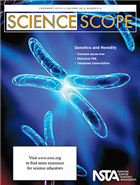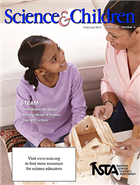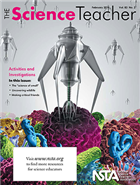Ideas and information from NSTA's February K-12 journals
By Mary Bigelow
Posted on 2016-02-21
This month, all three journals include Planning NGSS-Based Instruction: Where Do You Start? This article is another must-read for teachers who are looking for ideas to incorporate student questions and interests with the Next Generation Science Standards.
The lessons in all three journals include detailed graphic organizers showing how the authors would align the lesson to the NGSS. And if you’re interested in writing for an NSTA publication, the TST editor has some suggestions and encouragement!
A great benefit of NSTA is that members can access all of the journals online. So check out ideas that can be adapted for your students, regardless of grade level.

Science Scope – Genetics and Heredity
This month’s featured articles have ideas for incorporating crosscutting concepts and science practices with the content in genetics units.
- Using Local Street Trees to Teach the Concept of Common Ancestry has a lesson (available online) that goes beyond simply identifying trees to studying evolutionary relationships among species.
- From Mendel to Me: Constructing Genetics Knowledge Through Historical Problem-Based Learning provides a different context for traditional topics such as Punnett squares and
- Pass the DNA, Please uses a variation of the “telephone” game to simulate the idea of genetic transcription and translation and mutations.
- Controversial Environmental Issues Explored Through Interdisciplinary Perspectives: The Case of the Bald Eagle, the Botanical Garden, and the Airport has a real-life context for examining the relationships (sometimes controversial) between human needs and wildlife habitats.
- This month’s Guest Editorial Epigenetics: A New Science for Middle School—And Why You Should Teach It has a good overview of this growing field of science, along with resources for learning more about it yourself.
For more on the content that provides a context for these projects and strategies see the SciLinks websites Biodiversity, Differentiation, DNA, Genetic Traits, Genetics, Genotypes, Identifying Trees, Leaf Structure and Function, Mendel’s Laws, Mendelian Genetics, Mutations, Punnett Squares.
Continue for Science and Children and The Science Teacher.
 Science and Children – STEAM
Science and Children – STEAM
“Brainstorming solutions and creating scientific investigations can be enhanced through an innovative, creative, artistic approach.” (S&C editor).
- Mars Colony integrates role-playing into a simulated exploration of the planet (photographs included).
- Amazing Muses of Science shares the experience of students writing and performing a play that highlights contributions of women scientists.
- Kindergarten students, Ornithologists By Design, design, construct, and evaluate bird feeders in their own school-based “sanctuary.”
- Based on a book they read in class. Start With a Story has the story of students working with a zoo on interdisciplinary activities, such as designing animal habitats.
- In Luminous Lighting, students went beyond constructing simple circuits and applied what they know to creating wire sculptures that light up.
- Teaching Through Trade Books: The Science of Art has two 5E lessons in which students explore the science of crayons and how balloons such as those in parades are designed and engineered. For more on color, see Science 101: What’s Going on When You Mix Colors?
- The Early Years: Fostering Environmental Stewardship illustrates how students can communicate what they learn about nature through making and displaying collages. Methods and Strategies: Using Acorns to Generate an Entire Alphabet has ideas for enhancing language development through teachable moments during outdoor activities.
- Safety First: Safety Picks Up “STEAM” is another must-read article for elementary teachers to pro-actively design safe learning activities.
- Engineering Encounters: What Makes a Superhero “Super”? explores the concept of gravity.
For more on the content that provides a context for these projects and strategies see the SciLinks websites Birds, Colors, Current Electricity, Forces and Motion, Gases, Gravity, Matter, Habitats, States of Matter, Physical Properties of Matter, Planets, Space Exploration.
 The Science Teacher – Activities and Investigations
The Science Teacher – Activities and Investigations
The featured articles have lots of ideas and resources for NGSS-aligned investigations in the life and physical sciences.
- Uncovering Wildlife includes a 5E lesson for turning the school grounds into an authentic research center using “cover boards” (photos included) to collect data on species that live there.
- Making Critical Friends describes a process for guiding pairs of students through the process of scientific argumentation around socioscientific issues such as energy sources, climate change, or GMOs.
- Shedding Light on the “Science of Small” has a 5E lesson in which students investigate titanium oxide nanoparticles as catalysts activated by UV radiation. The detailed article also includes photographs.
- A Virtuous Cycle introduces the Formative Assessment Design Cycle, a collaborative plan for designing common assessments. The cycle is illustrated in the context of a lesson in natural selection and the development of birds’ beaks.
- Finding Patterns describes an alternative to lectures and memorization for learning about how compounds are named, guiding students through pattern identification.
- Science 2.0: Mastering Scientific Practices With Technology recommends technology tools that support the NGSS science and engineering practices of Asking Questions and Defining Problems, Developing and Using Models, and Planning and Carrying Out Investigations.
- The Green Room: Conserving Tropical Rain Forests suggests resources for looking at conservation efforts and preserving biodiversity in these environments.
- Health Wise: Getting Past the Peak of Flu Season lists topics students could investigate related to the spread of diseases.
For more on the content that provides a context for these projects and strategies see the SciLinks websites Biodiversity, Bird Adaptations, Characteristics of Birds, Genetically Modified Crops, Habitat, Infectious Diseases, Naming Compounds, Nanotechnology, Rain Forests, Vaccinations, Viruses.
Disclaimer: The views expressed in this blog post are those of the author(s) and do not necessarily reflect the official position of the National Science Teaching Association (NSTA).


